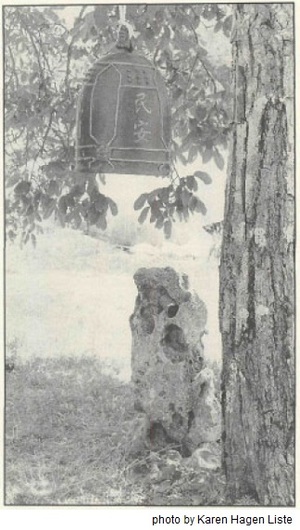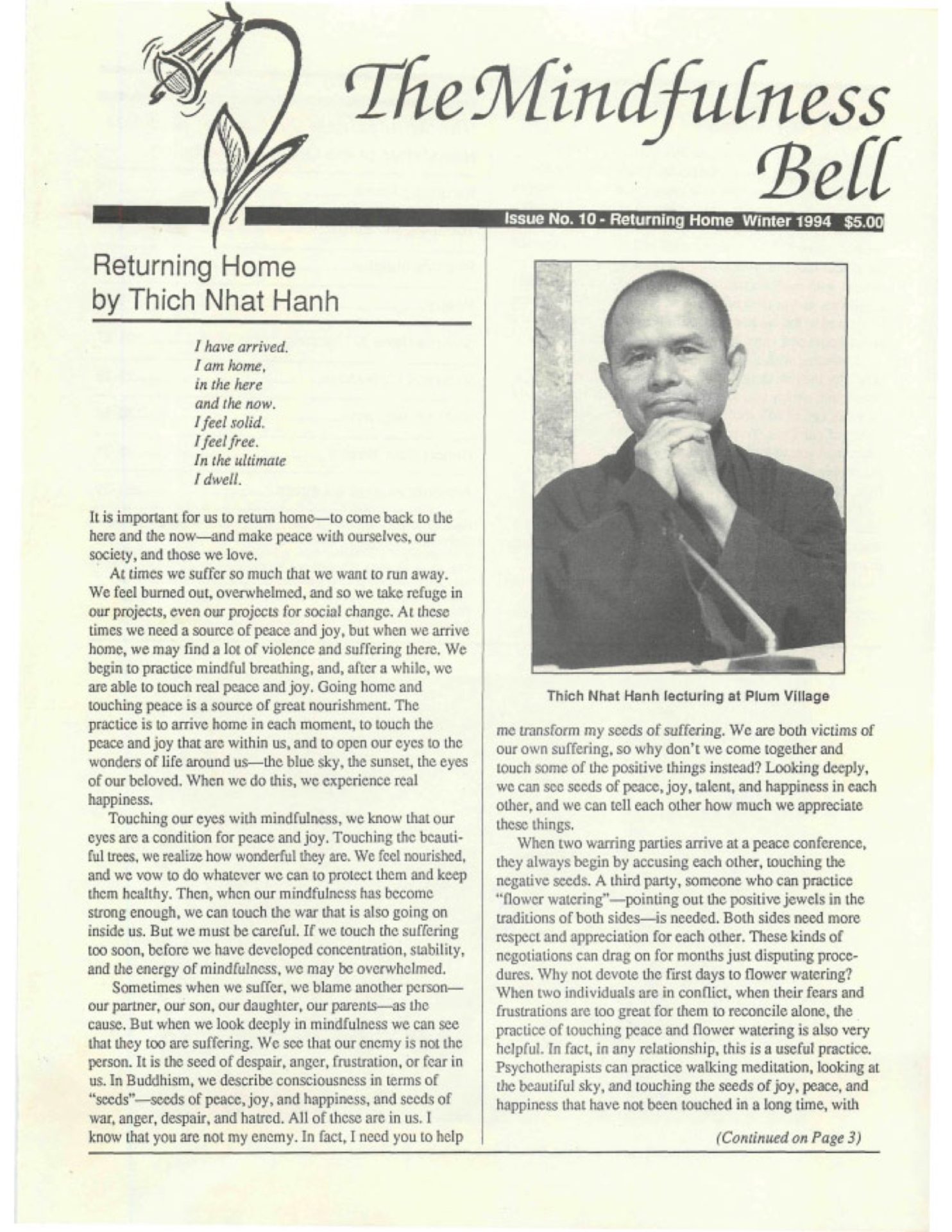By Andrew Weiss
On the evening of April 6, 1993, Pham Gia Binh, a quiet, dedicated practitioner of Pure Land Buddhism, immolated himself in Ellington, Connecticut, in the presence of five friends. Binh made this offering of himself to alert us to the continued violation of human rights in Vietnam, and the continued mistreatment of Buddhist monks and nuns there. He left behind many letters—to the government of Vietnam, to President Clinton, to the Secretary General of the United Nations,
By Andrew Weiss
On the evening of April 6, 1993, Pham Gia Binh, a quiet, dedicated practitioner of Pure Land Buddhism, immolated himself in Ellington, Connecticut, in the presence of five friends. Binh made this offering of himself to alert us to the continued violation of human rights in Vietnam, and the continued mistreatment of Buddhist monks and nuns there. He left behind many letters—to the government of Vietnam, to President Clinton, to the Secretary General of the United Nations, and to his Dharma brothers and sisters, both Vietnamese and non-Vietnamese, in which he brought our attention to this situation and expressed his hope that government officials in Vietnam would see the virtue of restoring human rights and treating the monks with respect. Binh was a member of our temple, Hoi Phat Giao, in Roslindale. For all of us, Binh's act and its inevitable consequences have entered our lives in tangible ways. In addition, Binh's five witnesses, all Vietnamese members of the temple, were charged by the state of Connecticut with the crime of assisting a suicide. The temple helped in their defense.
When I heard of Binh's immolation, I went numb. I saw this as similar to immolations I remembered from the Vietnam War, only it was not something I was seeing on film. It was an act that directly involved my friends and myself. I had no context in which to place this event. There were many martyrs for Judaism—people who offered their lives as a protest or to awaken others to the need for action—but these were all people who died at the hands of others. All of my cultural upbringing urged me to see Binh's act as pathological.
Thay has written that such an immolation is not a suicide. "It is not even a protest," he wrote to Dr. Martin Luther King, in reference to the self-immolation of Buddhist monks in Vietnam in 1963. "What the monks said in the letters they left before burning themselves aimed only at alarming, at moving the hearts of the oppressors, and at calling the attention of the world to the suffering endured at that time by the Vietnamese.. .This is not suicide. Suicide is an act of self-destruction, having as causes the following: lack of courage to live and to cope with difficulties; defeat by life and loss of all hope; desire for nonexistence." Thay went on to say that, while suicide is prohibited in Buddhism, this kind of self-sacrifice for the sake of others is an act of love and compassion.
I attended Binh's funeral and was able to see the grief and love of his friends and family and also to see how deeply touched people were by his act. The ceremony, in which Binh was declared a bodhisattva by the Venerable Thich Man Giac, moved me deeply. I saw photographs and drawings of Binh, and in his face I saw deep commitment, resolution, and compassion.
Over the following weeks, I had the opportunity to read Binh's letters, the last entry in his diary (written the day before his immolation), and his carefully compiled list of things to be done before the act itself—to talk with the five witnesses to the act, all of whom knew Binh and for whom he had been a teacher of the Dharma and a spiritual guide; and to meet and talk with Thay Man Giac, and with my friends Bich and Chi. Through this, I learned that Binh had made a vow to offer himself in this way nine years ago and had waited until he felt the time was right. I learned that he had pledged the five young men to secrecy, and that they had all tried to convince him not to do it, to no avail. I also learned that he had always wanted to be a monk and that he lived almost as a monk here in the United States—working in the post office and devoting the rest of his time to the temple, the Buddhist Youth Group, and his family. I learned of his dedication to prayer, chanting meditation, the Three Refuges, and the Five Precepts. I learned that the walls of his apartment were painted with many pictures of Buddhas, and that he seemed to live in the mundane world and in the Pure Land simultaneously.
As I began to see more clearly the purity and sincerity of Binh's intention, I began to live with this question: Binh offered himself completely and without reservation to that moment; he offered the most precious thing he could, out of his love and compassion; how can I offer myself that completely to this moment? I have sat, walked, eaten, worked, slept, talked, and done everything with that question ever since.
One answer is that I can bring attention to the human rights situation and the mistreatment of Buddhist monks and nuns in Vietnam. This answer springs from something very deep. At the moment Binh set fire to himself, he was the embodiment of bodhicitta (the desire to be awake). He was completely awake and present. My deepest desire is to live like this. I don't mean to offer my life through immolation. I mean to offer myself completely and with the greatest sincerity I can to each moment.
Binh's witnesses videotaped and photographed the immolation. Binh wanted them to do this because getting images of the immolation out to the public would accomplish an important part of Binh's purpose. However, these were all seized by the police when they were called to the scene. The Connecticut court does not want these images on the television news. Even without the videotape, however, Binh's act has had an impact. We have learned that the Vietnamese government ordered a search of all Buddhist temples and monasteries after the event. There have been two subsequent immolations in Vietnam, and a third attempted immolation was unsuccessful. There was also a demonstration of some 40,000 people in Vietnam on May 31,1993, protesting against the government.
The dilemma of the videotape and photos, and the different perspectives of the Vietnamese Buddhist community and the Connecticut law enforcement community, highlights the underlying dilemma of the aftermath of Binh's immolation. The great majority of the most venerable Vietnamese monks in the U.S. as well as many people within the Vietnamese Buddhist community see Binh's act of compassion not as a suicide. They are careful to say that this does not mean that they support people immolating themselves, and all of them with whom I have spoken said they would have tried to convince Binh not to do it had they known in advance. The Connecticut state's attorney reflects the Western view: What Binh did was take his own life, and taking one's own life is suicide. The state's attorney's office has emphasized that there is no exclusion for religious acts in their suicide law.
Therefore, one crux of the five young men's defense of their actions in witnessing Binh's immolation and helping him set up his immolation pallet is whether or not Binh's act is a suicide. And it is this crux which both defines and reflects the greater question as Vietnamese Buddhism encounters U.S. Judeo-Christianity. Do we see immolation as a selfless act of love and compassion, or as a sinful act to be punished?
We at the Hoi Phat Giao Temple have been trying to educate the public on how immolation is viewed in the history of Vietnamese Buddhism. We have done this through careful contact with the media, and by talking with friends and small groups of people. The reactions have varied from shock, to understanding, to incomprehension. My Western Buddhist friends mostly have been stunned by this, and there has been a deep silence as they have absorbed this information. One friend told me that she could understand a compulsion which drove someone to do it, but she still could not accept it. Another person called me after seeing my name in the newspaper, told me he was a Buddhist, and he said that nothing in Buddhism supports immolation, and that he saw no difference between Binh's action and that of David Koresh and the Branch Davidians in Waco.

I believe it is important to the fruit of Binh's action, to help create a greater understanding of immolation, and the reason Binh did it in as wide a community as possible. Sometimes this gets into a discussion of life and death, and helping people look deeply into the reality of no-coming and no-going.
My hope is that people will take Binh's action to heart and take action to support his purpose in whatever way they feel is appropriate. Living the precepts, with great attention to the impact of our actions, is one way. Letters to President Clinton, the government of Vietnam, and other world leaders, bringing the human rights situation in Vietnam to their attention and asking for change, are always helpful. In particular, it would be helpful to address President Clinton and the U.S. Congresspeople about linking the lifting of the trade embargo with human rights in Vietnam.
Andrew Weiss, True Shining, is a lawyer and mediator in Cambridge, Massachusetts.

